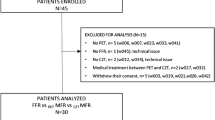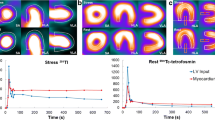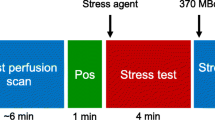Abstract
Background
SPECT myocardial perfusion imaging (MPI) is a clinical mainstay that is typically performed with static imaging protocols and visually or semi-quantitatively assessed for perfusion defects based upon the relative intensity of myocardial regions. Dynamic cardiac SPECT presents a new imaging technique based on time-varying information of radiotracer distribution, which permits the evaluation of regional myocardial blood flow (MBF) and coronary flow reserve (CFR). In this work, a preliminary feasibility study was conducted in a small patient sample designed to implement a unique combined static-dynamic single-dose one-day visit imaging protocol to compare quantitative dynamic SPECT with static conventional SPECT for improving the diagnosis of coronary artery disease (CAD).
Methods
Fifteen patients (11 males, four females, mean age 71 ± 9 years) were enrolled for a combined dynamic and static SPECT (Infinia Hawkeye 4, GE Healthcare) imaging protocol with a single dose of 99mTc-tetrofosmin administered at rest and a single dose administered at stress in a one-day visit. Out of 15 patients, eleven had selective coronary angiography (SCA), 8 within 6 months and the rest within 24 months of SPECT imaging, without intervening symptoms or interventions. The extent and severity of perfusion defects in each myocardial region was graded visually. Dynamically acquired data were also used to estimate the MBF and CFR. Both visually graded images and estimated CFR were tested against SCA as a reference to evaluate the validity of the methods.
Results
Overall, conventional static SPECT was normal in ten patients and abnormal in five patients, dynamic SPECT was normal in 12 patients and abnormal in three patients, and CFR from dynamic SPECT was normal in nine patients and abnormal in six patients. Among those 11 patients with SCA, conventional SPECT was normal in 5, 3 with documented CAD on SCA with an overall accuracy of 64%, sensitivity of 40% and specificity of 83%. Dynamic SPECT image analysis also produced a similar accuracy, sensitivity, and specificity. CFR was normal in 6, each with CAD on SCA with an overall accuracy of 91%, sensitivity of 80%, and specificity of 100%. The mean CFR was significantly lower for SCA detected abnormal than for normal patients (3.86±1.06 vs 1.94±0. 0.67, P < 0.001).
Conclusions
The visually assessed image findings in static and dynamic SPECT are subjective, and may not reflect direct physiologic measures of coronary lesion based on SCA. The CFR measured with dynamic SPECT is fully objective, with better sensitivity and specificity, available only with the data generated from the dynamic SPECT method.



Similar content being viewed by others
Abbreviations
- SCA:
-
Selective Coronary angiography
- CABG:
-
Coronary bypass graft surgery
- CAD:
-
Coronary artery disease
- CFR:
-
Coronary flow reserve
- MBF:
-
Myocardial blood flow
- MPI:
-
Myocardial perfusion imaging
- PCI:
-
Percutaneous coronary intervention
- PET:
-
Positron emission tomography
- SPECT:
-
Single-photon emission computed tomography
- CT:
-
Computed Tomography
References
Shaw LJ, Iskandrian AE. Prognostic value of gated myocardial perfusion SPECT. J Nucl Cardiol. 2004;11:171-85.
Sciagra R, Leoncini M. Gated single-photon emission computed tomography. The present-day “one-stop-shop” for cardiac imaging. Q J Nucl Med Mol Imaging. 2005;49:19-29.
Beller GA, Bergmann SR. Myocardial perfusion imaging agents: SPECT and PET. J Nucl Cardiol. 2004;11:71-86.
Huang JY, Huang CK, Yen RF, Wu HY, Tu YK, Cheng MF, et al. Diagnostic performance of attenuation-corrected myocardial perfusion imaging for coronary artery disease: A systematic review and meta-analysis. J Nucl Med. 2016;57:1893-8.
Shrestha U, Sciammarella M, Alhassen F, Yeghiazarians Y, Ellin J, Verdin E, et al. Measurement of absolute myocardial blood flow in humans using dynamic cardiac SPECT and 99mTc-tetrofosmin: Method and validation. J Nucl Cardiol. 2017;24:268-77.
Jin M, Yang Y, King MA. Reconstruction of dynamic gated cardiac SPECT. Med Phys. 2006;33:4384-94.
Iida H, Eberl S. Quantitative assessment of regional myocardial blood flow with Thallium-201 and SPECT. J Nucl Cardiol. 1998;5:313-31.
Alhassen F, Nguyen N, Bains S, Gould RG, Seo Y, Bacharach SL, et al. Myocardial blood flow measurement with a conventional dual-head SPECT/CT with spatiotemporal iterative reconstructions—a clinical feasibility study. Am J Nucl Med Mol Imaging. 2013;4:53-9.
Chen LC, Lin CY, Chen IJ, Ku CT, Chen YK, Hsu B. SPECT myocardial blood flow quantitation concludes equivocal myocardial perfusion SPECT studies to increase diagnostic benefits. Clin Nucl Med. 2016;41:e60–2.
Hsu B, Hu LH, Yang BH, Chen LC, Chen YK, Ting CH, et al. SPECT myocardial blood flow quantitation toward clinical use: A comparative study with 13N-ammonia PET myocardial blood flow quantitation. Eur J Nucl Med Mol Imaging. 2017;44:117-28.
Nkoulou R, Fuchs TA, Pazhenkottil AP, Kuest SM, Ghadri JR, Stehli J, et al. Absolute myocardial blood flow and flow reserve assessed by gated SPECT with cadmium-zinc-telluride detectors using 99mTc-tetrofosmin: Head-to-head comparison with 13N-ammonia PET. J Nucl Med. 2016;57:1887-92.
Gullberg GT, Reutter BW, Sitek A, Maltz JS, Budinger TF. Dynamic single photon emission computed tomography—basic principles and cardiac applications. Phys Med Biol. 2010;55:R111-91.
Ben-Haim S, Murthy VL, Breault C, Allie R, Sitek A, Roth N, et al. Quantification of myocardial perfusion reserve using dynamic SPECT imaging in humans: A feasibility study. J Nucl Med. 2013;54:873-9.
Ziadi MC, Dekemp RA, Williams K, Guo A, Renaud JM, Chow BJ, et al. Does quantification of myocardial flow reserve using rubidium-82 positron emission tomography facilitate detection of multivessel coronary artery disease? J Nucl Cardiol. 2012;19:670-80.
Beanlands RS, Ziadi MC, Williams K. Quantification of myocardial flow reserve using positron emission imaging the journey to clinical use. J Am Coll Cardiol. 2009;54:157-9.
Murthy VL, Naya M, Foster CR, Hainer J, Gaber M, Di Carli G, et al. Improved cardiac risk assessment with noninvasive measures of coronary flow reserve. Circulation. 2011;124:2215-24.
Herzog BA, Husmann L, Valenta I, Gaemperli O, Siegrist PT, Tay FM, et al. Long-term prognostic value of 13N-ammonia myocardial perfusion positron emission tomography added value of coronary flow reserve. J Am Coll Cardiol. 2009;54:150-6.
Slomka PJ, Berman DS, Germano G. Absolute myocardial blood flow quantification with SPECT/CT: Is it possible? J Nucl Cardiol. 2014;21:1092-5.
Slomka P, Berman DS, Germano G. Myocardial blood flow from SPECT. J Nucl Cardiol. 2016;24:278-81.
Wells RG, Timmins R, Klein R, Lockwood J, Marvin B, deKemp RA, et al. Dynamic SPECT measurement of absolute myocardial blood flow in a porcine model. J Nucl Med. 2014;55:1685-91.
Shepp LA, Vardi Y. Maximum likelihood reconstruction for emission tomography. IEEE Trans Med Imaging. 1982;1:113-22.
Shrestha UM, Seo Y, Botvinick EH, Gullberg GT. Image reconstruction in higher dimensions: Myocardial perfusion imaging of tracer dynamics with cardiac motion due to deformation and respiration. Phys Med Biol. 2015;60:8275-301.
Winant CD, Aparici CM, Zelnik YR, Reutter BW, Sitek A, Bacharach SL, et al. Investigation of dynamic SPECT measurements of the arterial input function in human subjects using simulation, phantom and human studies. Phys Med Biol. 2012;57:375-93.
Hudson HM, Larkin RS. Accelerated image reconstruction using ordered subsets of projection data. IEEE Trans Med Imaging. 1994;13:601-9.
Legrand V, Hodgson JM, Bates ER, Aueron FM, Mancini GB, Smith JS, et al. Abnormal coronary flow reserve and abnormal radionuclide exercise test results in patients with normal coronary angiograms. J Am Coll Cardiol. 1985;6:1245-53.
Gould KL, Johnson NP, Bateman TM, Beanlands RS, Bengel FM, Bober R, et al. Anatomic versus physiologic assessment of coronary artery disease. Role of coronary flow reserve, fractional flow reserve, and positron emission tomography imaging in revascularization decision-making. J Am Coll Cardiol. 2013;62:1639-53.
Yoshinaga K, Manabe O, Tamaki N. Absolute quantification of myocardial blood flow. J Nucl Cardiol. 2016;48:1783.
Schelbert HR, Phelps ME, Hoffman E, Huang SC, Kuhl DE. Regional myocardial blood flow, metabolism and function assessed noninvasively with positron emission tomography. Am J Cardiol. 1980;46:1269-77.
Schindler TH, Facta AD, Prior JO, Campisi R, Inubushi M, Kreissl MC, et al. Pet-measured heterogeneity in longitudinal myocardial blood flow in response to sympathetic and pharmacologic stress as a non-invasive probe of epicardial vasomotor dysfunction. Eur J Nucl Med Mol Imaging. 2006;33:1140-9.
Garcia EV. Are SPECT measurements of myocardial blood flow and flow reserve ready for clinical use? Eur J Nucl Med Mol Imaging. 2014;41:2291-3.
Petretta M, Storto G, Pellegrino T, Bonaduce D, Cuocolo A. Quantitative assessment of myocardial blood flow with SPECT. Prog Cardiovasc Dis. 2015;57:607-14.
Timmins R, Klein R, Petryk J, Marvin B, Wei L, deKemp RA, et al. Reduced dose measurement of absolute myocardial blood flow using dynamic SPECT imaging in a porcine model. Med Phys. 2015;42:5075-83.
Nose N, Fukushima K, Lapa C, Werner RA, Javadi MS, Taki J, et al. Assessment of coronary flow reserve using a combination of planar first-pass angiography and myocardial SPECT: Comparison with myocardial 15O-water PET. Int J Cardiol. 2016;222:209-12.
Wang L, Wu D, Yang Y, Chen IJ, Lin CY, Hsu B, et al. Avoiding full corrections in dynamic SPECT images impacts the performance of SPECT myocardial blood flow quantitation. J Nucl Cardiol. 2016. doi:10.1007/s12350-016-0513-4.
Joutsiniemi E, Saraste A, Pietila M, Maki M, Kajander S, Ukkonen H, et al. Absolute flow or myocardial flow reserve for the detection of significant coronary artery disease? Eur Heart J Cardiovas Imaging. 2014;15:659-65.
Parker MW, Iskandar A, Limone B, Perugini A, Kim H, Jones C, et al. Diagnostic accuracy of cardiac positron emission tomography versus single photon emission computed tomography for coronary artery disease: A bivariate meta-analysis. Circ Cardiovasc Imaging. 2012;5:700-7.
Chareonthaitawee P, Kaufmann PA, Rimoldi O, Camici PG. Heterogeneity of resting and hyperemic myocardial blood flow in healthy humans. Cardiovasc Res. 2001;50:151-61.
Beller GA, Zaret BL. Contributions of nuclear cardiology to diagnosis and prognosis of patients with coronary artery disease. Circulation. 2000;101:1465-78.
Acknowledgements
The authors would like to thank nuclear medicine technologists at the UCSF Imaging Center at China Basin for conducting patient scans. The study was supported in part by the National Institutes of Health under grant R01 HL050663.
Disclosure
The authors have no conflict of interest.
Author information
Authors and Affiliations
Corresponding author
Rights and permissions
About this article
Cite this article
Sciammarella, M., Shrestha, U.M., Seo, Y. et al. A combined static-dynamic single-dose imaging protocol to compare quantitative dynamic SPECT with static conventional SPECT. J. Nucl. Cardiol. 26, 763–771 (2019). https://doi.org/10.1007/s12350-017-1016-7
Received:
Revised:
Published:
Issue Date:
DOI: https://doi.org/10.1007/s12350-017-1016-7




